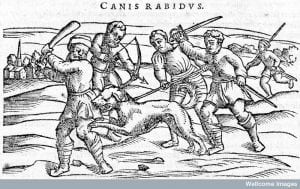Surgeon John Burnet shared “a very strange account” with Sir Hans Sloane in March 1720. The tale, sent to the French Académie des Sciences, had come straight from the Czar of Muscovy (Peter the Great) himself. Apparently,
a Man was bitt by a Mad-dog & that he lay with his wife the same night & after three fitts dyed, but that his wife was brought to bed nine weeks afterwards of five puppies.
Curious, indeed. Did this mean that rabies (or hydrophobia, as it was called) might be spread like a venereal disease? Or that the dog-bite had transmitted canine qualities into the infected man, which he then passed on to his offspring? Burnet was sceptical about account, noting “how far this is true, I know not”, but similar stories could be found in the Philosophical Transactions.

Rabies: Slaying a mad dog. From Dioscordes, Acera de la materia medicinal y de los venenos, 1556. Credit: Wellcome Library, London.
Physician Martin Lister, for example, wrote “An Observation of Two Boys Bit by a Mad Dog” (1698). Back in 1679, two boys aged nine and ten washed the head wounds of a dog that had been bitten by a mad dog. The injured dog was saved, but several months later, the boys became ill with stomach pains and convulsions.
What suggested a diagnosis of hydrophobia was that, by August 1680, the boys feared the water and had become, well, a bit dog-like. They regularly went into simultaneous fits that would last an hour, during which time “the Eldest especially, snarled, barked and endeavoured to bite like a Dog”. By September, “they became more wild” and, even after the fits had passed, could not endure the company of people. They had become more animal than human. The case seemed dire, but the boys were on the mend by the end of September.
Clergyman and antiquary, Abraham de la Pryme, wrote to Sloane in 1702 about a 1695 case from his brother’s household (see also Phil. Trans. 23, 1702-3). De la Pryme noted the regularity of timing in several cases, but was particularly intrigued by the way that tiny “Particles of this Poyson” could spread to infect a “mass of particles millions of times bigger”.
This case started with a “pretty grey-hound Bitch that had Whelps” being bitten by a mad dog. Three weeks later, the greyhound also went mad and had to be put down. The puppies appeared well and were looked after, but (again) three weeks later, “all pull’d out one anothers throats except one”. This one continued to eat, but would drink no liquid. Two servants caring for the puppy stuck their fingers into its mouth to check for a blockage, but there was none. The puppy soon went mad.
Three weeks later, both servants became ill. One, “a most strong and laborious Man”, managed to sweat off his symptoms: acute headache, tightened throat and red eyes (which makes me think of Black Shuck’s fiery eyes). But the fourteen-year old apprentice was much sicker. He became so savage that it took four adult men to hold him down
and all his discourse was of fighting, and how if that they would but let him alone, he would leap upon them, and bite, and tear them to pieces.
He soon lost his ability to speak altogether (one of the marks of humanity), then died.
The economic problem of the disease was obvious, as it could easily spread to livestock. In George Dampier’s recipe for rabies (published in the Phil. Trans.), Dampier reported that his remedy “did [his neighbours] a Hundred Pound’s Worth of Good” during a local outbreak when it saved their cattle.
But the social consequences of transmission was even more worrying. Rabies was, after all, considered a type of poison (see here and here), but so too was venereal disease, which could also be passed to one’s offspring. The real fear? That the mad animal’s qualities might be passed on to the human—or, worse yet, the victim’s children.
As De la Pryme concluded in his account, it was a pity “that the most Noble of creatures lyes at the Mercy of the most ignoble of particles”, but a wonder “that a few Atoms should be able to destroy a whole world”.